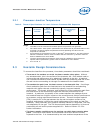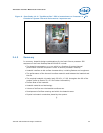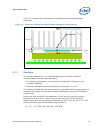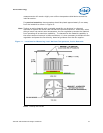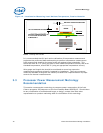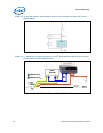
Thermal Metrology
Thermal and Mechanical Design Guidelines 27
3 Thermal Metrology
This section discusses guidelines for testing thermal solutions, including measuring
processor temperatures. In all cases, the thermal engineer must measure power
dissipation and temperature to validate a thermal solution. To define the performance
of a thermal solution the “thermal characterization parameter”, Ψ (“psi”) will be used.
3.1 Characterizing Cooling Performance
Requirements
The idea of a “thermal characterization parameter”, Ψ (“psi”), is a convenient way to
characterize the performance needed for the thermal solution and to compare thermal
solutions in identical situations (same heat source and local ambient conditions). The
thermal characterization parameter is calculated using total package power.
Note: Heat transfer is a three-dimensional phenomenon that can rarely be accurately and
easily modeled by a single resistance parameter like Ψ.
The junction-to-local ambient thermal characterization parameter value (Ψ
JA
) is used
as a measure of the thermal performance of the overall thermal solution that is
attached to the processor package. It is defined by the following equation, and
measured in units of °C/W:
Equation 2 Ψ
JA
= (T
J
– T
A
) / P
D
Where:
Ψ
JA
= Junction-to-local ambient thermal characterization parameter (°C/W)
T
J
= Processor junction temperature (°C)
T
A
= Local ambient temperature in chassis at processor (°C)
P
D
= Processor total power dissipation (W) (assumes all power dissipates
through the processor die)



